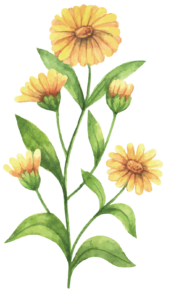 Common names: Pot marigold, common marigold, English marigold
Common names: Pot marigold, common marigold, English marigold
Latin name: Calendula officinalis (Asteraceae)
Appearance: An annual that can reach three feet high with bright orange flowers that resemble daisies.
Habitat: Native to Southern Europe but can be found in temperate regions worldwide.
Properties: Anti-inflammatory, antispasmodic, astringent, hemostatic, antimicrobial, wound healing
Parts used: Flower heads and petals
Primary preparations: Infusion, tincture, cream, ointment, infused oil
Practical uses: Acne; athlete’s foot; bites and stings; inflammed skin rashes, hives, diaper rash; wounds; bruises and varicose veins
Calendula vs. marigold: Though its common names suggest otherwise, calendula is NOT a marigold. While both are from the sunflower (Asteraceae) family, marigold is from the Tagetes genus, with over 50 species, whereas calendula is from the calendula genus, with ~20 species. Besides differences in petal and seed shapes, calendula is edible and pleasant smelling, whereas marigold is toxic and unpleasant smelling (a great pest deterrent in the garden).
*Consult with a qualified healthcare professional before attempting to self-treat ailments.
SOURCE: Chevallier A. Encyclopedia of Herbal Medicine. New York, NY: DK Publishing; 2016:56.





